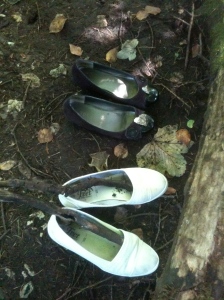Everyday Readymades
October 24, 2013
Photo: Everyday Objects by Rhea Batz
“Experimentation also involves attention to the normally unnoticed” (Allan Kaprow, Essays on the Blurring of Art and Life)
Does newly produced art have to always be made in art therapy? Or, can art therapy also incorporate personally significant collection of everyday objects? The readymade objects that inhabit domestic life, work, leisure and daily experiences are many. Gathering and assembling items that have symbolic meaning can act as a condensed personal archive. Combining different dimensions of life into a mini-installation, or life sculpture, brings into relationship many kinds of experiences. Allan Kaprow used the idea of “life like art” to describe art that reminds us of the rest of our lives. He encouraged us to be conscious inventors of the life that also invents us. How can we revision the materials we interact with on a daily basis as artworks in art therapy?
It’s a strange thought, that personal identity and qualities of mind and character can be discovered not only in people, but also in objects, landscapes, jars or boxes. If this seems a bit odd, it’s because we have, by and large, emptied the visual realm of personal character. Yet when we feel kinship with an object, it is because the values we sense that it carries are clearer in it than they usually are in our minds (Alain de Botton and John Armstrong)
In his book The Poetics of Space, Gaston Bachelard describes how domestic objects are in essence hybrids in their role as subject-objects. Subject-objects are intimately felt, they are handled items that reflect what we hold on to for practical and symbolic reasons. A subject-object could be a piece of clothing, photograph, pen, mobile phone, a piece of jewellery, an inherited ornament, or something picked up off the street. The organisation and display of a ready-made assemblage can be a vital composition, highlighting the life situations of an art therapy participant in a concrete way. Reconstituting ordinary objects into a re-mixing of meaning (or finding the valuable in the taken-for-granted) is not only a guide to self-knowledge, but a way to replenish awareness of what’s around us.
Photo: A Display of Shoes and Sticks, Belfast Art Therapy Summer School, 2013
A recent article in the Financial Times by Susie Boyt called “Identity in a Biscuit Tin” describes the work of Christian Boltanski, whose recent installation at the Pompidou Centre in Paris is composed of 646 old biscuit tines, containing 1200 photographs and 800 documents gathered by the artist from his studio over a 23 year period. Boyt writes, “standing in front of Les Archives made me think of so many things: exile, humility, childhood, home, concealment and display, and how we as humans come to measure and regard our own personal history, our memories, and our suffering”
Photo: Les archives de Christian Boltanski 1965-1989, placed in biscuit tins.
From personal objects arranged as a documentation of experience, to biscuit tins as containers of personal history, the subject of what is an art material in art therapy requires critical consideration. Using everyday readymades is a means of inviting art therapy participants to “come as they are” to “be themselves” rather than fitting into art materials that don’t suit how they live their lives.
It’s a strange thought, that personal identity and qualities of mind and character can be discovered not only in people, but also in objects, landscapes, jars or boxes. It this seems a bit odd, it’s because we have, by and large, emptied the visual realm of personal character. Yet when we feel a kinship with an object, it is because the values we sense that it carries are clearer in it than they usually are in our minds (Alain de Botton and John Armstrong).
It is important for people to feel at home in art therapy, to feel relaxed and share who they are. The Irish artist Kate Murphy’s writes that home
…is an extension of The Self, an archetype of both physical and psychological boundaries and the primary site of the development of personal, cultural, gender and sexual identity. The house or dwelling, as an artefact, serves as a source of materials, forms and objects with which to investigate notions of social convention, ritual, nostalgia and the unconscious. (Home) is personally grounded in expressions of longing, loss, embodiment and the duality of protection versus isolation (Kate Murphy, Exhibition Catalogue).
Subject-objects picked from home and found in life, sculpt a series of stories waiting to be heard. These items are the autobiographical grounds of subjectivity as it travels through neighbourhoods, streets, paths, and different zones of life activity.
References
The Poetics of Space by Gaston Bachelard
Art as Therapy by Alain de Botton and John Armstrong
“Identity in a Biscuit Tin” by Susie Boyt (Financial Times)
The Blurring of Art and Life by Allan Kaprow
Kate Murphy, http://katemurphyartwork.blogspot.ie/


